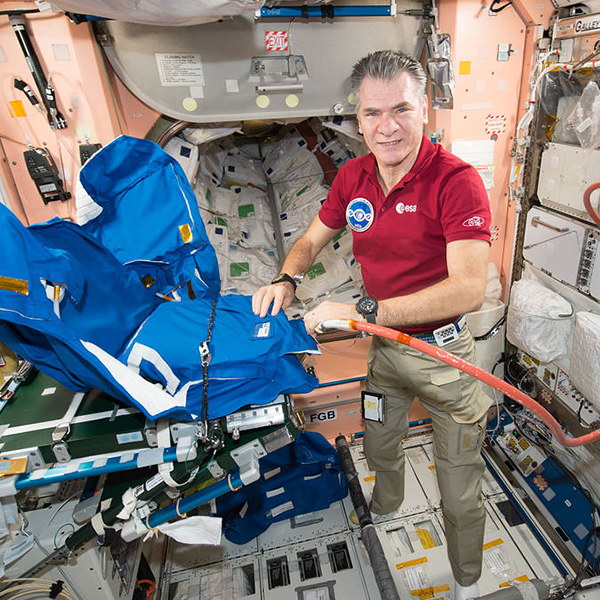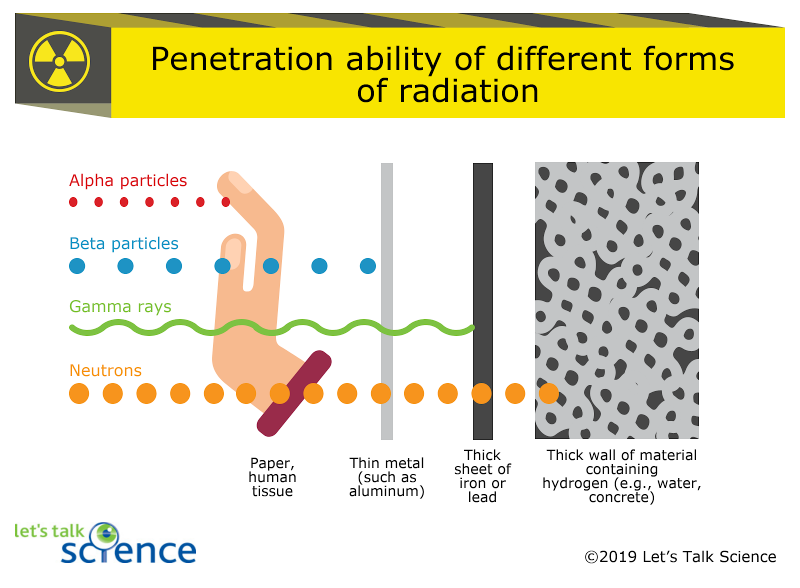Radiation and Human Space Exploration

Radiation shielding garment on the International Space Station (NASA)

Radiation shielding garment on the International Space Station (NASA)
How does this align with my curriculum?
One of the greatest hazards that humans in space face is cosmic radiation. Learn what cosmic radiation is, why it's dangerous, and ways that we are looking at protecting humans in deep space.
Where does radiation come from?
Radiation is everywhere on Earth. It is in the air, water, food, soil, and in all living organisms. Radiation also comes from the Sun and other stars. This is called cosmic radiation.
Cosmic radiation includes two types of radiation. Electromagnetic radiation is made up of rays such as gamma rays or X-rays. Particle radiation can include neutrons, alpha particles, or beta particles. These come from the nuclei of heavy atoms such as iron.
Fortunately, Earth’s atmosphere and magnetosphere (magnetic field) help absorb and filter this radiation. Some radiation does pass through these protective barriers. However, we are protected from high doses of cosmic radiation.
What are the Dangers of Radiation for Human Space Travel?
Cosmic radiation is one of the greatest dangers for people travelling into space. Cosmic ray particles are charged particles that are highly energetic. They are a form of ionizing radiation. This type of radiation is dangerous to people and machines in space. When these particles collide with the particles of other objects, they can split their molecules. This can result in the formation of secondary particles, such as neutrons and other subatomic particles.
As you have learned, radiation can come from neutrons, alpha particles, beta particles and gamma rays. But neutrons penetrate matter at a deeper level than other forms of radiation. In humans, neutron radiation can damage cells or cause them to mutate. These cells may become cancerous, or die.

Image - Text Version
Shown is a colour diagram illustrating how different sorts of radiation penetrate different objects.
At the top of the panel, the title is in black letters on a bright yellow rectangle: Penetration ability of different forms of radiation. On the left is a yellow radiation symbol on a black background.
Below is a row of illustrations of different materials. On the left is a human hand. This is labelled Paper, human tissue. Next is a thin grey strip. This is labelled Thin metal (such as aluminum). Next is a thick, dark, grey strip. This is labelled Thick sheet of iron or lead. On the right is large rectangle with a pattern of light and dark grey circles. This is labelled Thick wall of material containing hydrogen (e.g., water, concrete).
Alpha particles are represented by a line of small red dots. This line starts on the left and stops at the human hand.
Beta particles are represented by a line of medium-sized blue dots. This line goes through the human hand and stops at the thin metal.
Gamma rays are represented by a wavy green line. This line goes through the human hand and the thin metal, and stops at the thick metal.
Neutrons are represented by a line of large orange dots spaced close together. This line goes through the human hand, the thin metal, the thick metal, and into the surface of the thick wall of material containing hydrogen.
Because of the dangers of cosmic radiation, scientists are concerned about its impact on humans. They are especially concerned about astronauts and cosmonauts who spend long periods of time in space.
Spacecrafts have special shielding that helps stop cosmic radiation from penetrating the inside of the craft. Spacesuits are designed to do the same thing. These spacesuits are particularly important for astronauts visiting the Moon, Mars, or asteroids.
Even though we have these precautions, scientists still are not sure how extended exposure to cosmic radiation impacts astronauts and cosmonauts. Scientists think that prolonged exposure to cosmic radiation might cause cancer or heart disease. But according to a 2019 study, people who have travelled to space so far are no more likely to die of cancer or heart disease than people who have not. This may be because most astronauts and cosmonauts have travelled to low Earth orbit. There, the Earth’s magnetic field still protects them. Also, astronauts and cosmonauts do not usually spend more than a few consecutive months in space. But scientists worry about how longer trips in deep space will affect space travellers. For example, how will cosmic radiation impact people who visit Mars?
Did you know?
The record for most consecutive days in space is held by Russian cosmonaut Valery Polyakov. His flight aboard the Mir Space Station from 1994 to 1995 lasted 438 days, or about 15 months.
We still have a lot to learn about cosmic radiation’s long-term effects on humans in space. Scientists are learning more about this topic every day. They are doing experiments at the NASA Space Radiation Laboratory in Brookhaven, NY and on the International Space Station!
Starting Points
- Would you be willing to travel to space despite the risk of exposure to cosmic radiation? Why or why not?
- Have you had an x-ray at the dentist’s office? Why does the dentist place a heavy apron over your body and neck when they are taking an x-ray? What protective material does that apron contain?
- Why is there still more research needed on the effects of radiation in space?
- How does Earth’s environment protect humans from cosmic radiation?
- What is cosmic radiation and what forms of radiation does it include?
- Why is ionizing radiation destructive in the human body?
- What form of ionizing radiation is the most dangerous to human health?
- Explain how ionizing radiation can affect the human body.
- How are astronauts physically protected from cosmic radiation while traveling in space or when living and working on the ISS? What other methods of protection are being explored?
- Why are the effects of radiation exposure on humans in space still an experiment in progress?
- How might innovations in science and technology create a working environment in space that exposes astronauts to less cosmic radiation?
- This video and article can be used to support teaching and learning of Space Science, Space, Physics, Health, Waves, Sound, Light, Space Exploration and Heat and Energy related to radiation, particle physics and human spaceflight. Concepts introduced include radiation, cosmic radiation, electromagnetic radiation, particle radiation, magnetosphere, ionizing radiation, neurons and mutate.
- Before viewing this video and reading the article, teachers could have students complete a Vocabulary Preview learning strategy to engage their prior knowledge and introduce new terminology. Ready-to-use Vocabulary Preview reproducibles are available in [Google doc] and [PDF] formats.
- During and after viewing the video and reading the article, teachers could have students use a Print-Video Venn Diagram learning strategy to organize and compare the information from both resources. Ready-to use Print Video Venn Diagram reproducibles are available in [Google doc] and [PDF] formats.
- To explore this topic further, students could also read the backgrounders Radiation Effects on the Body and Radiation Effects on Cells and DNA.
Connecting and Relating
- Would you be willing to travel to space despite the risk of exposure to cosmic radiation? Why or why not?
- Have you had an x-ray at the dentist’s office? Why does the dentist place a heavy apron over your body and neck when they are taking an x-ray? What protective material does that apron contain?
Relating Science and Technology to Society and the Environment
- Why is there still more research needed on the effects of radiation in space?
- How does Earth’s environment protect humans from cosmic radiation?
Exploring Concepts
- What is cosmic radiation and what forms of radiation does it include?
- Why is ionizing radiation destructive in the human body?
- What form of ionizing radiation is the most dangerous to human health?
- Explain how ionizing radiation can affect the human body.
- How are astronauts physically protected from cosmic radiation while traveling in space or when living and working on the ISS? What other methods of protection are being explored?
Nature of Science/Nature of Technology
- Why are the effects of radiation exposure on humans in space still an experiment in progress?
- How might innovations in science and technology create a working environment in space that exposes astronauts to less cosmic radiation?
Teaching Suggestions
- This video and article can be used to support teaching and learning of Space Science, Space, Physics, Health, Waves, Sound, Light, Space Exploration and Heat and Energy related to radiation, particle physics and human spaceflight. Concepts introduced include radiation, cosmic radiation, electromagnetic radiation, particle radiation, magnetosphere, ionizing radiation, neurons and mutate.
- Before viewing this video and reading the article, teachers could have students complete a Vocabulary Preview learning strategy to engage their prior knowledge and introduce new terminology. Ready-to-use Vocabulary Preview reproducibles are available in [Google doc] and [PDF] formats.
- During and after viewing the video and reading the article, teachers could have students use a Print-Video Venn Diagram learning strategy to organize and compare the information from both resources. Ready-to use Print Video Venn Diagram reproducibles are available in [Google doc] and [PDF] formats.
- To explore this topic further, students could also read the backgrounders Radiation Effects on the Body and Radiation Effects on Cells and DNA.
Learn more
Dangerous Space Radiation Poses Threat to Mars Mission Astronauts (2017)
Video (2:31 min.) from VideoFromSpace discussing the three sources of radiation and how they’re a concern to scientists as they plan a mission to Mars.
A Superconducting Shield for Astronauts (2015)
News briefing from CERN about the newly developed superconducting shield that may be able to protect astronauts from cosmic radiation while they’re in space
References
Dunbar, B. (2018, June 11). Why space radiation matters. NASA.
Dvorsky, G. (2019, July 4). Astronauts aren’t dying from space radiation, new research suggests. Gizmodo.
Howell, E. (2018, May 11). What are cosmic rays? Space.com.
Mirion Technologies. (2015, April 3). Types of ionizing radiation.
Wall, M. (2019, April 23). The most extreme human spaceflight records. Space.com.